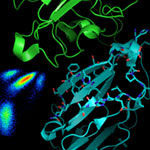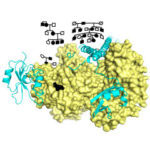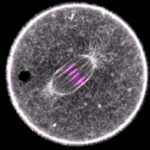
Research from Greg Jefferis’s group in the LMB’s Neurobiology Division has uncovered a biological switch that determines which part of the fruit fly’s brain responds to pheromones, depending on whether the fruit fly is male or female.
MRC Laboratory of Molecular Biology
One of the world's leading research institutes, our scientists are working to advance understanding of biological processes at the molecular level - providing the knowledge needed to solve key problems in human health.

Research led by Professor Nick Brindle at the University of Leicester and Julian Sale from the LMB’s PNAC Division has resulted in the production of a molecule that has great therapeutic potential in the treatment of inflammatory conditions. Much of the work took place while Nick was on sabbatical at the LMB and involved additional input from Dr Hiroshi Arakawa in Italy and Dr Jean-Marie Buerstedde at Yale.
Angiopoietins play a critical role in the development and maintenance of blood vessels.

New research from Philipp Holliger’s group in the LMB’s PNAC Division demonstrates the power RNA could have wielded to enable the first forms of life on Earth to reproduce and thrive.
At its most basic level, all life can be viewed as a mechanism for self-replication: organisms reproduce by making new copies of themselves and of the genetic information that defines them.

Work led by Sergey Nejentsev and Alison Condliffe from the University of Cambridge, in collaboration with Roger Williams’ group in the LMB’s PNAC Division and Klaus Okkenhaug’s group at the Babraham Institute has discovered a rare genetic disease which predisposes patients to severe respiratory infections and lung damage.

Work carried out by Michael Hastings’ group in the LMB Neurobiology’s Division, together with collaborators at Leicester, Bangor and Aberystwyth Universities has combined expertise in molecular genetics and marine biology to address a long-standing question about tidal behaviour in marine organisms. They were interested in whether these animals are driven by a dedicated internal tidal clock or are controlled by a system based on a modified 24-hour circadian clock.

Work carried out by Melina Schuh’s group in the LMB’s Cell Biology Division has provided new insights into how the spindle is asymmetrically positioned in oocytes, which is a vital step in the development of a fertilizable egg in mammals.
The oocyte is stored in the ovary in meiotic arrest until ovulation. At ovulation, the primary oocyte completes meiosis I and discards half of its chromosomes in a small cell termed the polar body.